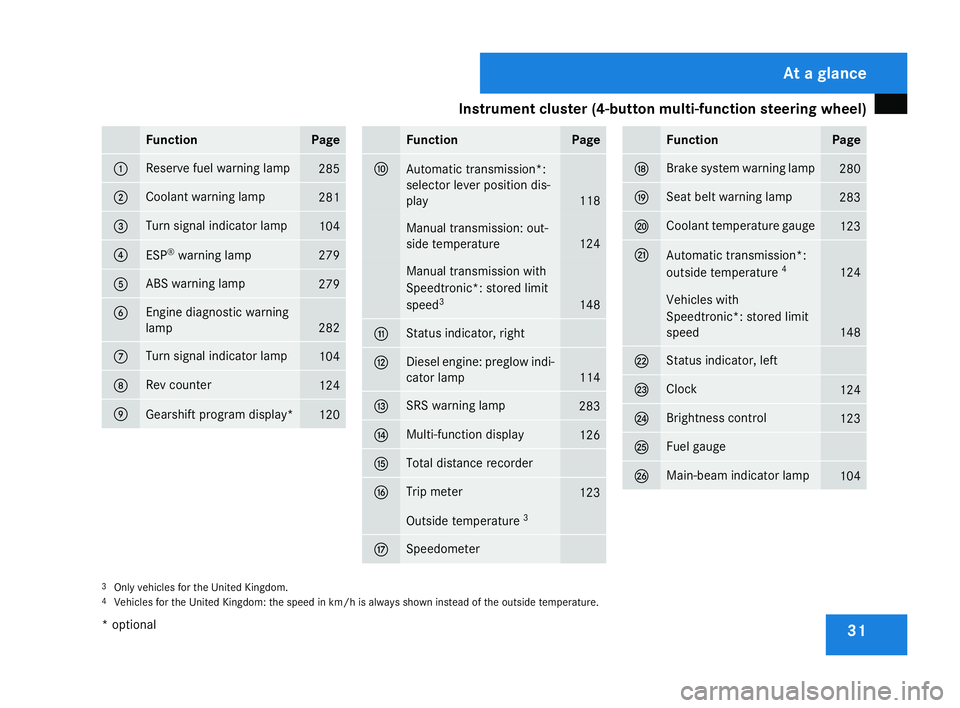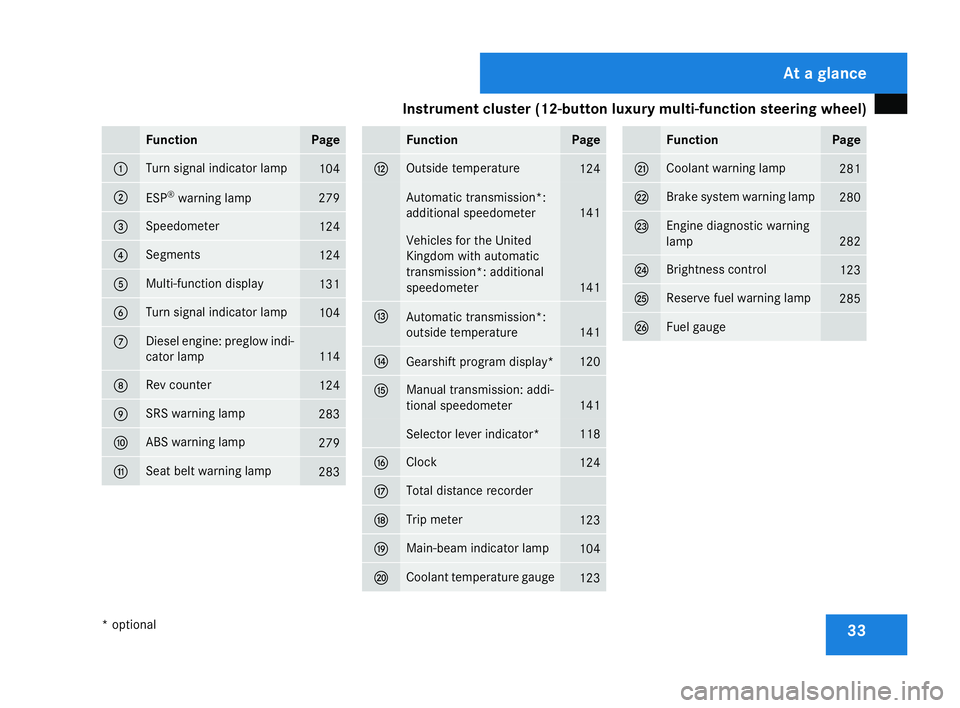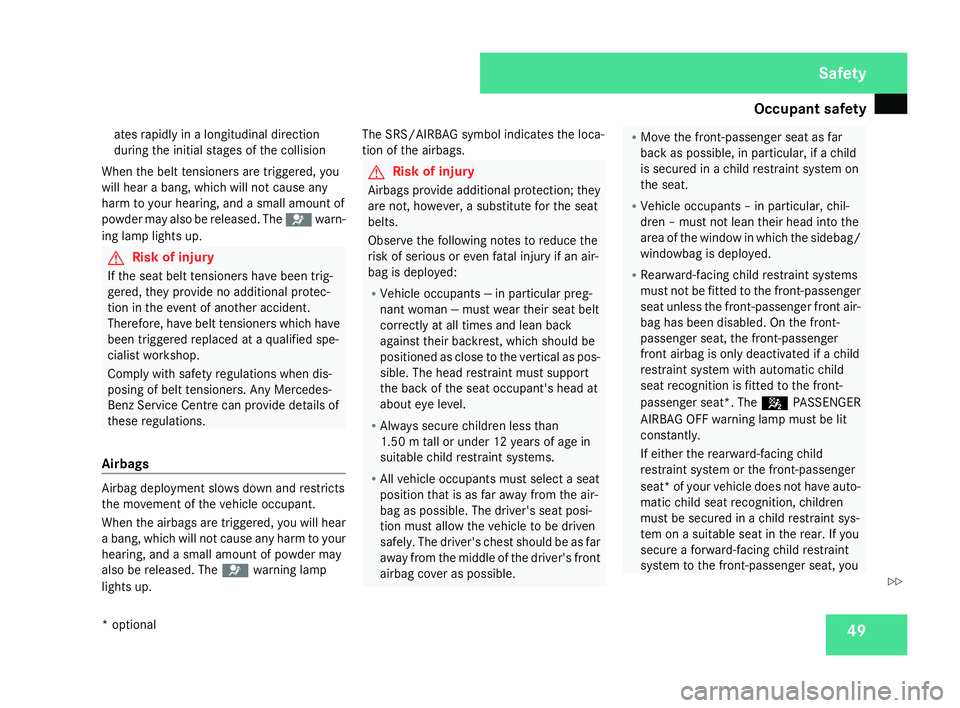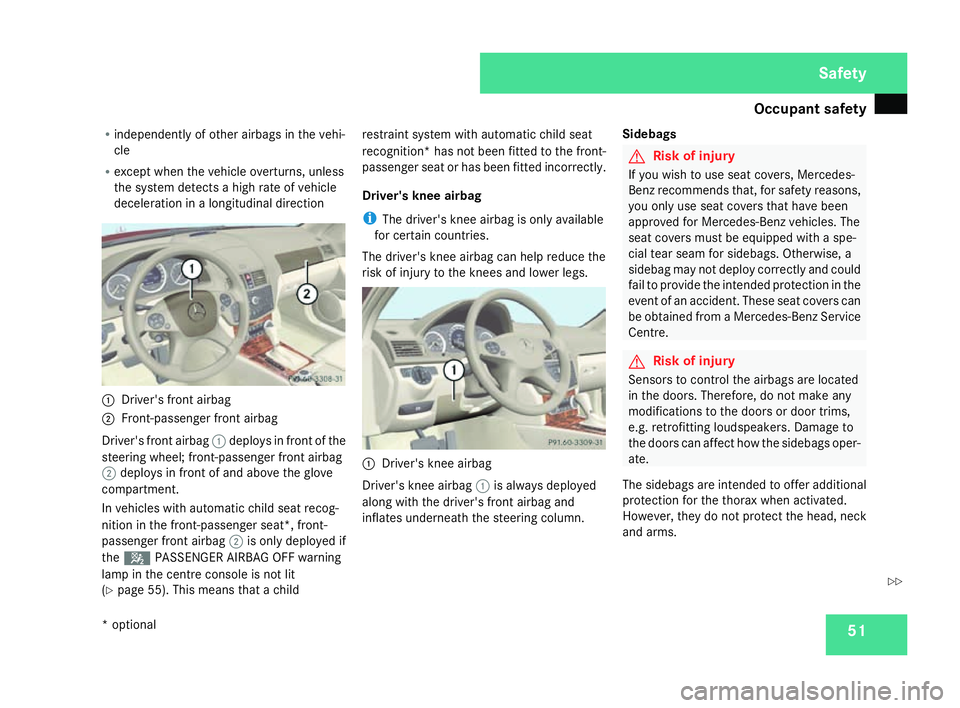2007 MERCEDES-BENZ C-CLASS ESTATE warning
[x] Cancel search: warningPage 34 of 377

Instrument cluster (4-button multi-function steering wheel)
31Function Page
1 Reserve fuel warning lamp
28
5 2 Coolant warning lamp
28
1 3 Turn signal indicator lamp
104
4
ESP
®
warning lamp 27
9 5 ABS warning lamp
279
6 Engine diagnostic warning
lamp
282
7 Turn signal indicator lamp
104
8 Rev counter
12
4 9
Gearshift program display*
12
0 Function Pag
e a
Automatic transmission*
:
selector lever position dis-
play 118
Manual transmission: out-
side temperature
124
Manual transmission with
Speedtronic*: stored limit
speed
3 148
b Status indicator, right
c Diesel engine: preglow indi-
cator lamp
114
d SRS warning lamp
283
e Multi-function display
126
f Total distance recorder
g Trip meter
123
Outside temperature
3 h Speedometer Function Pag
e j Brake system warning lamp
280
k Seat belt warning lamp
283
l Coolant temperature gauge
12
3 m
Automatic transmission*
:
outside temperature 4 124
Vehicles with
Speedtronic*: stored limit
spee
d 148
n Status indicator, left
o Cloc
k 124
p Brightness control
123
q Fuel gaug
e r Main-beam indicator lamp
104
3
Only vehicles for the United Kingdom.
4 Vehicles for the United Kingdom: the speed in km/h is always shown instead of the outside temperature. At a glance
* optional
204_AKB; 2; 3, en-GB
mkalafa,
2007-06-26T23:11:51+02:00 - Seite 31
Page 36 of 377

Instrument cluster (12-button luxury multi-function steering wheel)
33Function Page
1 Turn signal indicator lamp
104
2
ESP
®
warning lamp 27
9 3 Speedometer
124
4 Segments
124
5 Multi-function display
131
6 Turn signal indicator lamp
104
7 Diesel engine: preglow indi-
cator lamp
114
8 Rev counter
12
4 9 SRS warning lamp
283
a ABS warning lamp
279
b Seat belt warning lamp
283 Function Pag
e c Outside temperature
124
Automatic transmission*:
additional speedometer
141
Vehicles for the United
Kingdom with automatic
transmission*: additional
speedometer 141
d
Automatic transmission*
:
outside temperature 141
e
Gearshift program display* 12
0 f Manual transmission: addi-
tional speedometer
141
Selector lever indicator* 118
g Cloc
k 124
h Total distance recorder
j Trip meter
123
k Main-beam indicator lamp
104
l Coolant temperature gauge
12
3 Function Pag
e m Coolant warning lamp
28
1 n Brake system warning lamp
280
o Engine diagnostic warning
lamp 282
p Brightness control
123
q Reserve fuel warning lamp
28
5 r Fuel gaug
e At a glance
* optional
204_AKB; 2; 3, en-G
B
mkalafa , 2007-06-26T23:11:51+02:00 - Seite 33
Page 38 of 377

Instrument cluster (12-button luxury multi-function steering wheel)
35Function Page
1 Turn signal indicator lamp
104
2
ESP
®
warning lamp 27
9 3 Speedometer
124
4 Segments
124
5 Multi-function display
131
6 Turn signal indicator lamp
104
7 Diesel engine: preglow indi-
cator lamp
114
8 Rev counter
12
4 9 SRS warning lamp
283
a ABS warning lamp
279
b Seat belt warning lamp
283 Function Pag
e c Outside temperature
124
Automatic transmission*:
additional speedometer
141
Vehicles for the United
Kingdom with automatic
transmission*: additional
speedometer 141
d
Automatic transmission*
:
outside temperature 141
e
Gearshift program display* 12
0 f Manual transmission: addi-
tional speedometer
141
Selector lever indicator* 118
g Cloc
k 124
h Total distance recorder
j Trip meter
123
k Main-beam indicator lamp
104
l Coolant temperature gauge
12
3 Function Pag
e m Coolant warning lamp
28
1 n Brake system warning lamp
280
o Engine diagnostic warning
lamp 282
p Brightness control
123
q Reserve fuel warning lamp
28
5 r Fuel gaug
e At a glance
* optional
204_AKB; 2; 3, en-G
B
mkalafa , 2007-06-26T23:11:51+02:00 - Seite 35
Page 41 of 377

Centre console
38 Centre console
Upper section Function Page
1 Switches the hazard warn-
ing lamps on/of
f 105
2
ATA indicator lamp* 71
3 5
PASSENGER AIRBA G
OFF warning lamp 5 55
4 Deactivates/activate
s
ESP ® 69
5
Controls COMAND APS*
and the audio system*; see
the respective operating
instruction
s 6
Switches the seat heating*
on the right-hand front sea t
on/off 91
7 Activates/deactivate
s
Parktronic * 153
8 Saloon: rolls the rear win-
dow blind* up/down
196 Function Pag
e 9 Switches ADVANCED AGIL
-
ITY package with sports
mode* on/off 152
a Controls Thermatic
15
8 Controls Thermotronic* 16
5 Switches the rear window
heating on/of
f 173
b
Switches the seat heating*
on the left-hand front sea
t
on/off 91
i
The layout of the buttons may differ
depending on the equipment in the vehicle.
5 The warning lamp also lights up briefly when you turn the key to position 2 in the ignition lock on vehicles which do not have automatic child seat recognition on the
front-passenger seat*. It has no function, however, and does not indicate that the front-passenger seat is equipped with automatic child seat recognition*. At a glance
* optional
204_AKB; 2; 3, en-GB
mkalafa,
2007-06-26T23:11:51+02:00 - Seite 38
Page 50 of 377

Occupant safet
y 47In particular, work relevant to safety or on
safety-related systems must be carried out
at a qualified specialist workshop. If this
work is not carried out correctly, the oper-
ating safety of your vehicle may be affec -
ted. There is a risk of an accident and injury .SRS (Supplemental Restraint System)
The SRS reduces the risk of occupants com-
ing into contact with the vehicle's interior in
the event of an accident.
The SRS consists of:
R The SRS warning lamp =
R Belt tensioners
R Belt force limiters
R Airbag s
The SRS warning lamp ==The SRS functions are checked regularly
when you turn on the ignition and when the
engine is running. Malfunctions can therefore
be detected in good time.
The = warning lamp in the instrumen t
cluster lights up when you switch on the igni -tion and goes out a few seconds after the
engine is started
. G
Risk of injury
If SRS is malfunctioning, individual systems
may be activated unintentionally or not be
triggered in the event of an accident with
heavy braking.
A malfunction has occurred if the =
warning lamp:
R does not light up when you switch on the
ignition
R does not go out after the engine has been
running for a few seconds
R lights up again once the engine is running
In this case, have SRS checked immedi-
ately at a qualified specialist workshop.
Triggering of belt tensioners, belt force
limiters and airbags In the event of a collision, the sensor in the
airbag control unit evaluates important phys-
ical data such as duration, direction and force
of the vehicle deceleration or acceleration.
Based on the evaluation of this data and
depending on the vehicle's rate of longitudi-
nal deceleration in a collision, in the firs
tstage the airbag control unit pre-emptively
triggers the belt tensioners.
The front airbags are only deployed if there is
an even higher rate of vehicle deceleration in
a longitudinal direction.
If your vehicle is fitted with adaptive dual-
stage front airbags, the front airbag is filled
with enough gas to reduce the risk of injuries
at the first deployment threshold. The front
airbag is only fully inflated if a second thresh-
old is reached within a few milliseconds due
to the control unit having detected further
deceleration.
i
The front belt tensioners can only be trig-
gered if the belt tongue is correctly
engaged in the seat belt buckle.
Criteria for triggering belt tensioners and
airbags
In the first stages of a collision, the sensor in
the airbag control unit evaluates physical
data such as duration, direction and rate of
vehicle deceleration or acceleration in order
to determine whether it is necessary to trig-
ger the belt tensioners and/or airbags.
The belt tensioner and airbag triggerin g
thresholds are variable and are adapted to the
rate of deceleration of the vehicle. This proc-
ess is pre-emptive in nature as the airba g Safety
204_AKB; 2; 3, en-GB
mkalafa,
2007-06-26T23:11:51+02:00 - Seite 47 Z
Page 51 of 377

Occupant safet
y48
must be deployed during – and not at the end
of – the collision
.
i Airbags are not deployed in all types of
accident. They are controlled by comple x
sensor technology and evaluation logic.
This process is pre-emptive in nature as
airbag deployment must take place during
the impact and must be adapted to provide
calculated, additional protection for the
vehicle occupants. Not all airbags are
deployed in an accident.
The different airbag systems work inde-
pendently of each other. However, the
deployment of each individual system will
depend on the type of accident determined
by the control system in the first stages of
the collision (head-on collision, side impact
and overturn) and the extent of the acci-
dent (in particular, the vehicle's rate of
deceleration or acceleration).
The rate of vehicle deceleration or accelera-
tion and the direction of the force are basi-
cally determined by:
R the distribution of forces during the colli -
sion
R the collision angle R
the deformation characteristics of the vehi-
cle
R the characteristics of the object with which
the vehicle has collided, e.g. the other vehi-
cle
Factors which can only be seen and measured
after the collision has taken place do not play
a decisive role in the deployment of an airbag,
nor do they provide an indication of it.
The vehicle may be considerably deformed
without an airbag being deployed if, for exam-
ple, only relatively easily deformable parts
such as the bonnet or wings have been hit and
the required rate of deceleration has not been
reached. It is also possible that airbags ma y
be deployed even though the vehicle is only
slightly deformed if, for example, very rigid
vehicle parts such as the longitudinal mem-
bers are hit in an accident and the rate of
deceleration is sufficient .
Belt tensioners, belt force limiters The front seat belts and the outer seat belts
in the rear are equipped with belt tensioners.
! Do not engage the seat belt tongue in the
buckle on the front-passenger seat if the
seat is not occupied. Otherwise the belt tensioner could be activated in an emer-
gency.
If the seat belt is also equipped with a belt
force limiter, the force exerted by the sea t
belt on the seat occupant is reduced.
Belt tensioners tighten the seat belts in an
accident, pulling them close against the body.
i Belt tensioners do not correct incorrect
seat positions or incorrectly fastened sea t
belts.
Belt tensioners do not pull occupants back
towards the backrest.
The front belt force limiters are synchronised
with the front airbags, which spread the
forces exerted by the belt force limiters on
the occupant over a greater area.
When the ignition is switched on, the belt ten -
sioner is triggered:
R only if the restraint systems are operational
(the = warning lamp lights up after th e
ignition is switched on and goes out onc e
the engine is running)( Ypage 47)
R for each three-point seat belt in the front of
the vehicle when the belt tongue is
engaged in the buckle
R in the event of a head-on or rear-end colli-
sion if the vehicle decelerates or acceler- Safety
204_AKB; 2; 3, en-GB
mkalafa,
2007-06-26T23:11:51+02:00 - Seite 48
Page 52 of 377

Occupant safet
y 49
ates rapidly in a longitudinal direction
during the initial stages of the collision
When the belt tensioners are triggered, you
will hear a bang, which will not cause any
harm to your hearing, and a small amount of
powder may also be released. The =warn-
ing lamp lights up. G
Risk of injury
If the seat belt tensioners have been trig -
gered, they provide no additional protec -
tion in the event of another accident.
Therefore, have belt tensioners which have
been triggered replaced at a qualified spe-
cialist workshop .
Comply with safety regulations when dis-
posing of belt tensioners. Any Mercedes-
Benz Service Centre can provide details of
these regulations.
Airbag s Airbag deployment slows down and restricts
the movement of the vehicle occupant.
When the airbags are triggered, you will hear
a bang, which will not cause any harm to your
hearing, and a small amount of powder ma y
also be released. The =warning lamp
lights up. The SRS/AIRBAG symbol indicates the loca-
tion of the airbags
. G
Risk of injury
Airbags provide additional protection; they
are not, however, a substitute for the sea t
belts.
Observe the following notes to reduce the
risk of serious or even fatal injury if an air-
bag is deployed:
R Vehicle occupants — in particular preg-
nant woman — must wear their seat belt
correctly at all times and lean back
against their backrest, which should be
positioned as close to the vertical as pos-
sible. The head restraint must support
the back of the seat occupant's head at
about eye level.
R Always secure children less tha n
1.50 mtall or under 12 years of age in
suitable child restraint systems.
R All vehicle occupants must select a sea t
position that is as far away from the air-
bag as possible. The driver's seat posi-
tion must allow the vehicle to be driven
safely. The driver's chest should be as far
away from the middle of the driver's fron t
airbag cover as possible. R
Move the front-passenger seat as far
back as possible, in particular, if a child
is secured in a child restraint system on
the seat.
R Vehicle occupants – in particular, chil-
dren – must not lean their head into the
area of the window in which the sidebag/
windowbag is deployed.
R Rearward-facing child restraint systems
must not be fitted to the front-passenger
seat unless the front-passenger front air-
bag has been disabled. On the front-
passenger seat, the front-passenger
front airbag is only deactivated if a child
restraint system with automatic child
seat recognition is fitted to the front-
passenger seat *.The 5 PASSENGER
AIRBAG OFF warning lamp must be li t
constantly .
If either the rearward-facing child
restraint system or the front-passenger
seat* of your vehicle does not have auto-
matic child seat recognition, childre n
must be secured in a child restraint sys-
tem on a suitable seat in the rear. If you
secure a forward-facing child restraint
system to the front-passenger seat, you Safety
* optiona l
204_AKB; 2; 3, en-GB
mkalafa,
2007-06-26T23:11:51+02:00 - Seite 49 Z
Page 54 of 377

Occupant safet
y 51
R
independently of other airbags in the vehi-
cle
R except when the vehicle overturns, unless
the system detects a high rate of vehicle
deceleration in a longitudinal direction 1
Driver's front airba g
2 Front-passenger front airba g
Driver's front airbag 1deploys in front of the
steering wheel; front-passenger front airbag
2 deploys in front of and above the glove
compartment .
In vehicles with automatic child seat recog-
nition in the front-passenger seat*, front-
passenger front airbag 2is only deployed if
the 5 PASSENGER AIRBAG OFF warning
lamp in the centre console is not lit
( Y page 55). This means that a child restraint system with automatic child seat
recognition* has not been fitted to the front-
passenger seat or has been fitted incorrectly.
Driver's knee airba
g
i The driver's knee airbag is only available
for certain countries.
The driver's knee airbag can help reduce the
risk of injury to the knees and lower legs. 1
Driver's knee airba g
Driver's knee airbag 1is always deployed
along with the driver's front airbag and
inflates underneath the steering column. Sidebags G
Risk of injury
If you wish to use seat covers, Mercedes-
Benz recommends that, for safety reasons ,
you only use seat covers that have been
approved for Mercedes-Benz vehicles. The
seat covers must be equipped with a spe -
cial tear seam for sidebags. Otherwise, a
sidebag may not deploy correctly and could
fail to provide the intended protection in the
event of an accident. These seat covers can
be obtained from a Mercedes-Benz Service
Centre. G
Risk of injury
Sensors to control the airbags are locate d
in the doors. Therefore, do not make any
modifications to the doors or door trims,
e.g. retrofitting loudspeakers. Damage to
the doors can affect how the sidebags oper-
ate.
The sidebags are intended to offer additional
protection for the thorax when activated.
However, they do not protect the head, nec k
and arms. Safety
* optional
204_AKB; 2; 3, en-GB
mkalafa
, 2007-06-26T23:11:51+02:00 - Seite 51 Z